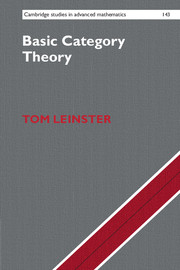Book contents
6 - Adjoints, representables and limits
Published online by Cambridge University Press: 05 August 2014
Summary
We have approached the idea of universal property from three different angles, producing three different formalisms: adjointness, representability, and limits. In this final chapter, we work out the connections between them.
In principle, anything that can be described in one of the three formalisms can also be described in the others. The situation is similar to that of cartesian and polar coordinates: anything that can be done in polar coordinates can in principle be done in cartesian coordinates, and vice versa, but some things are more gracefully done in one system than the other.
In comparing the three approaches, we will discover many of the fundamental results of category theory. Here are some highlights.
• Limits and colimits in functor categories work in the simplest possible way.
• The embedding of a category A into its presheaf category [Aop, Set] preserves limits (but not colimits).
• The representables are the prime numbers of presheaves: every presheaf can be expressed canonically as a colimit of representables.
• A functor with a left adjoint preserves limits. Under suitable hypotheses, the converse holds too.
• Categories of presheaves [Aop, Set] behave very much like the category of sets, the beginning of an incredible story that brings together the subjects of logic and geometry.
- Type
- Chapter
- Information
- Basic Category Theory , pp. 141 - 170Publisher: Cambridge University PressPrint publication year: 2014



